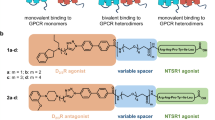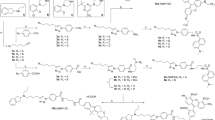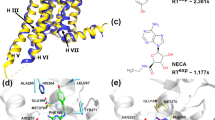Abstract
Aim:
To design and synthesize bivalent ligands for adenosine A1–dopamine D1 receptor heteromers (A1–D1R), and evaluate their pharmacological activities.
Methods:
Bivalent ligands and their corresponding A1R monovalent ligands were designed and synthesized. The affinities of the bivalent ligands for A1R and D1R in rat brain membrane preparation were examined using radiolabeled binding assays. To demonstrate the formation of A1–D1R, fluorescence resonance energy transfer (FRET) was conducted in HEK293 cells transfected with D1-CFP and A1-YFP. Molecular modeling was used to analyze the possible mode of protein-protein and protein-ligand interactions.
Results:
Two bivalent ligands for A1R and D1R (20a, 20b), as well as the corresponding A1R monovalent ligands (21a, 21b) were synthesized. In radiolabeled binding assays, the bivalent ligands showed affinities for A1R 10–100 times higher than those of the corresponding monovalent ligands. In FRET experiments, the bivalent ligands significantly increased the heterodimerization of A1R and D1R compared with the corresponding monovalent ligands. A heterodimer model with the interface of helixes 3, 4, 5 of A1R and helixes 1, 6, 7 from D1R was established with molecular modeling. The distance between the two ligand binding sites in the heterodimer model was approximately 48.4 Å, which was shorter than the length of the bivalent ligands.
Conclusion:
This study demonstrates the existence of A1–D1R in situ and a simultaneous interaction of bivalent ligands with both the receptors.
Similar content being viewed by others
Log in or create a free account to read this content
Gain free access to this article, as well as selected content from this journal and more on nature.com
or
References
Milligan G . G protein-coupled receptor dimerization: function and ligand pharmacology. Mol Pharmacol 2004; 66: 1–7.
Carriba P, Navarro G, Ciruela F, Ferre S, Casado V, Agnati L, et al. Detection of heteromerization of more than two proteins by sequential BRET-FRET. Nat Methods 2008; 5: 727–33.
George SR, O'Dowd BF, Lee SP . G-protein-coupled receptor oligomerization and its potential for drug discovery. Nat Rev Drug Discov 2002; 1: 808–20.
Milligan G . G-protein-coupled receptor heterodimers: pharmacology, function and relevance to drug discovery. Drug Discov Today 2006; 11: 541–9.
Franco R . Dopamine D1 and adenosine A1 receptors form functionally interacting heteromeric complexes. PNAS 2000; 97: 8606–11.
Franco R, Lluis C, Canela EI, Mallol J, Agnati L, Casadó V, et al. Receptor-receptor interactions involving adenosine A1 or dopamine D1 receptors and accessory proteins. J Neural Transm 2007; 114: 93–104.
Popoli P, Gimenez-Llort L, Pezzola A, Reggio R, Martinez E, Fuxe K . Adenosine A1 receptor blockade selectively potentiates the motor effects induced by dopamine D1 receptor stimulation in rodents. Neurosci Lett 1996; 218: 209–13.
Liu Z, Zhang J, Zhang A . Design of multivalent ligand targeting G-protein-coupled receptors. Curr Pharm Des 2009; 15: 682–718.
Russo O, Berthouze M, Giner M, Soulier JL, Rivail L, Sicsic S, et al. Synthesis of specific bivalent probes that functionally interact with 5-HT(4) receptor dimers. J Med Chem 2007; 50: 4482–92.
Christopoulos A, Grant MK, Ayoubzadeh N, Kim ON, Sauerberg P, Jeppesen L, et al. Synthesis and pharmacological evaluation of dimeric muscarinic acetylcholine receptor agonists. J Pharmacol Exp Ther 2001; 298: 1260–8.
Peng X, Neumeyer JL . Kappa receptor bivalent ligands. Curr Top Med Chem 2007; 7: 363–73.
Soriano A, Ventura R, Molero A, Hoen A, Casado V, Cortes A, et al. Adenosine A2A receptor-antagonist/dopamine D2 receptor-agonist bivalent ligands as pharmacological tools to detect A2A-D2 receptor heteromers. J Med Chem 2009; 52: 5590–602.
Miiller C, Schobert U, Hipp J, Geis U, Frobenius W, Pawlowski M . Configurationally stable analogs of styrylxanthines as A2A adenosine receptor antagonists. Eur J Med Chem 1997; 32: 709–19.
González MP, Terán C, Teijeira M . Search for new antagonist ligands for adenosine receptors from QSAR point of view. How close are we? Med Res Rev 2008; 28: 329–71.
Neumeyerc JL, Kula NS, Bergman J, Baldessarini RJ . Receptor affinities of dopamine D1 receptor-selective novel phenylbenzazepines. Eur J Pharmacol 2003; 474: 137–40
Zhang J, Xiong B, Zhen XC, Zhang A . Dopamine D1 receptor ligands: Where are we now and where are we going? Med Res Rev 2009; 29: 272–94.
Jiarpinitnun C, Kiessling L . Unexpected enhancement in biological activity of a GPCR ligand induced by an oligoethylene glycol substituent. J Am Chem Soc 2010; 132: 8844–5.
Mammen M, Shakhnovich E, Whitesides G . Using a convenient, quantitative model for torsional entropy to establish qualitative trends for molecular processes that restrict conformational freedom. J Org Chem 1998; 63: 3168–75.
Huber D, Lober S, Hubner H, Gmeiner P . Bivalent molecular probes for dopamine D2-like receptors. Bioorg Med Chem 2012; 20: 455–66.
Bakthavachalam V, Baindur N, Madras BK, Neumeyer JL . Fluorescent probes for dopamine receptors: synthesis and characterization of fluorescein and 7-nitrobenz-2-oxa-l,3-diazol-4-y conjugates of D-1 and D-2 receptor ligands. J Med Chem 1991; 34: 3235–41.
Wu P, Brand L . Resonance energy transfer: methods and applications. Anal Biochem 1994; 218: 1–13.
Jaakola VP, Griffith MT, Hanson MA, Cherezov V, Chien EY, Lane JR, et al. The 2.6 angstrom crystal structure of a human A2A adenosine receptor bound to an antagonist. Science 2008; 322: 1211–7.
Okada T, Sugihara M, Bondar AN, Elstner M, Entel P, Buss V . The retinal conformation and its environment in rhodopsin in light of a new 2.2 A crystal structure. J Mol Biol 2004; 342: 571–83.
Cherezov V, Rosenbaum DM, Hanson MA, Rasmussen SG, Thian FS, Kobilka TS, et al. High-resolution crystal structure of an engineered human beta(2)-adrenergic G protein-coupled receptor. Science 2007; 318: 1258–65.
Shimamura T, Shiroishi M, Weyand S, Tsujimoto H, Winter G, Katritch V, et al. Structure of the human histamine H1 receptor complex with doxepin. Nature 2011; 475: 65–70.
Hanson MA, Roth CB, Jo E, Griffith MT, Scott FL, Reinhart G, et al. Crystal structure of a lipid G protein-coupled receptor. Science 2012; 335: 851–5.
Chien EY, Liu W, Zhao Q, Katritch V, Han GW, Hanson MA, et al. Structure of the human dopamine D3 receptor in complex with a D2/D3 selective antagonist. Science 2010; 330: 1091–5.
Tarakanov AO, Fuxe KG . Triplet puzzle: homologies of receptor heteromers. J Mol Neurosci 2010; 41: 294–303.
Tarakanov AO, Fuxe KG . The triplet puzzle of homologies in receptor heteromers exists also in other types of protein-protein interactions. J Mol Neurosci 2011; 44: 173–7.
Kuhhorn J, Hubner H, Gmeiner P . Bivalent dopamine D2 receptor ligands: synthesis and binding properties. J Med Chem 2011; 54: 4896–903.
Acknowledgements
This study was supported by the '100 Talents Project' of CAS to Ye-chun XU and National S&T Major Project (No 2012ZX09301-001-005).
Author information
Authors and Affiliations
Corresponding authors
Rights and permissions
About this article
Cite this article
Shen, J., Zhang, L., Song, Wl. et al. Design, synthesis and biological evaluation of bivalent ligands against A1–D1 receptor heteromers. Acta Pharmacol Sin 34, 441–452 (2013). https://doi.org/10.1038/aps.2012.151
Received:
Accepted:
Published:
Issue date:
DOI: https://doi.org/10.1038/aps.2012.151
Keywords
This article is cited by
-
Adenosine A1-Dopamine D1 Receptor Heteromers Control the Excitability of the Spinal Motoneuron
Molecular Neurobiology (2019)
-
Neurochemical evidence supporting dopamine D1–D2 receptor heteromers in the striatum of the long-tailed macaque: changes following dopaminergic manipulation
Brain Structure and Function (2017)



